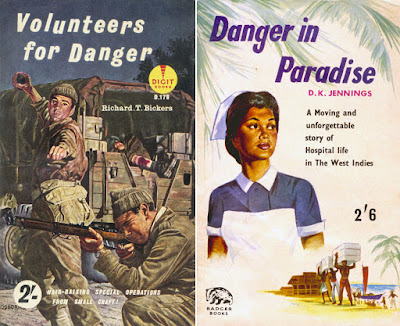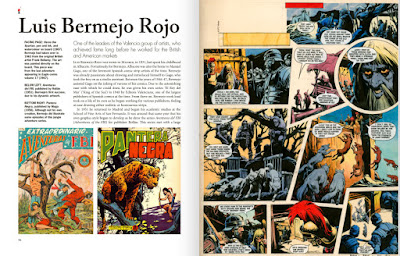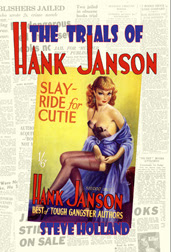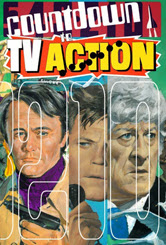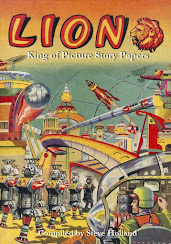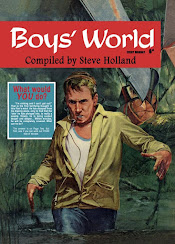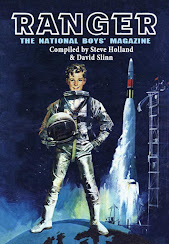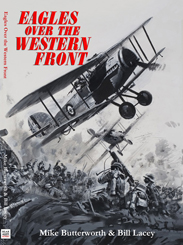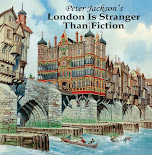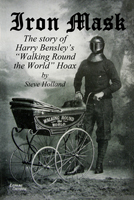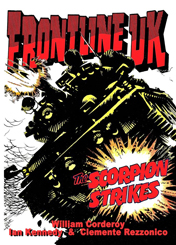Arriving with lots of internet fanfare and following on from a successful issue zero, which I thought was a solid start with one or two problems, we have Comic Scene #1. It's a bumper-sized celebration of women in comics, as both creators and characters, which is a splendid idea, but such a broad topic will always struggle to be all things to all people. The short (2- or 3-page) article format means that a lot can be covered in 80 pages, but space will always mean that your favourite might not have made the cut.
The most noticeable thing... well, the thing that I noticed, anyway, is that only 7 of the 80 pages were written by women; some of the interviews help with the balance, but a few more female voices would have been nice. And the article leading off this celebratory issue? "Why doesn't someone bring back Eagle?" which is the kind of thought-piece that might normally be run at the back of a mag.
The meat-and-gravy of the issue begins with a review of a book about Marie Duval (1847-1890), actress and artist who helped establish the character of Ally Sloper in the pages of Judy Magazine, sharing duties at first with Sloper's creator, her lover Charles Ross, and then taking over the character in 1870-77. We then jump to a look at Professor Peabody, one of Dan Dare's scientific team, which perhaps goes to emphasise how advanced the strip and its creator Frank Hampson was in terms of gender and race. Shame there was no mention of Helen Sharman, Britain's first astronaut, who seems to always be forgotten.
A brief lope through 25 years of Vertigo gets us to a brief interview with Karen Berger, mostly about Berger Books, her new imprint at Dark Horse, but managing not to mention a single project that she is currently working on, which include work by British creators like Dave Gibbons and Warren Pleece. Emma Beeby, another British Berger Books contributor (Mata Hari) is interviewed but, again, all too briefly with no space to discuss her work on 2000AD – she was the first woman to write Judge Dredd, which you would think would merit a little more space in an issue dedicated to women in comics. (Richard Bruton does make up for it a little with a look at the all-female 2000AD Sci-Fi Special later in the issue, as does Chris McAulay, with a nice tribute to Fay Dalton.)
Tim Hayes and Martin Dallard provide some of the issue's best pieces, on the Russian/Czech heroine Octobriana, who popped up in Luther Arkwright and Nikolai Dante; on Minnie the Minx; and on Cat Girl. Julia Round offers an overview of Misty comic, which only adds to the argument that the most innovative comics writing in the 1970s and 1980s was taking place in girls' comics, leaving boys' comics in their dusty wake. Nobody can argue that any innovations shown by Battle Picture Weekly and 2000AD owed a debt to what Wilf Prigmore, Gerry Finley-Day and others were doing in girls' comics.
Ice-skating heroine Valda, The Supercats and gymnast Bella at the Bar all come under the spotlight, as do 2000AD's Judge Anderson and Slaine. The latter allows Pat Mills to reveal just how influential his wife Angie Mills was in the creation of the character in an extract from his Kiss My Axe! book, which will be out at the end of the year. Pat also wraps up the issue with a look back at the girls' comics he worked on.
There are interviews with Sarah Laing on her fascination with Katherine Mansfield; Susie Gander on her battle against Hodgkin's lymphoma and her Kickstarter success, Periwinkle; and Rachael Smith on her web-comics and self-published comics.
Elsewhere we have a preview of The Vigilant, Rebellion's new team-up of old Fleetway characters; a look at Doctor Who's female companions; part 2 of John McShane's secret history of Toxic!; Liam Sharp talks about his time drawing Wonder Woman; Phil Clarke discusses the first British comic convention in 1968; and there's a look back at the art of Yvonne Hutton, who was the first woman to draw sports stories for Tiger in the 1960s.
There's a lot to like in this issue, but I'd still like to see a couple of longer interviews or retrospectives. And one thing has been bugging me since the cover was first displayed on the internet. "Laydeez Do Comics" is not, I suspect, going to sell many issues to the female audience. Quick rule of thumb: try it with a male nickname and misspell that and ask yourself: Do you think "Blerks Do Comics" will sell copies to men? If the answer is no, the same argument applies to the "Laydeez".
Details about subscriptions can be obtained from www.comicscene.org.
Rates for print issues for the UK are £5.99 for one issue; £35 for 6
issues; £68 for 12 issues.You can get a pdf version for £3.99 (1), £22
(6) or £40 (12).
Payment can be made via PayPal to comicsceneuk@gmail.com. For other options, and for international rates for the print edition, visit the website.
Monday, July 30, 2018
Saturday, July 28, 2018
Hutton Mitchell
HUTTON MITCHELL
by
Robert J. Kirkpatrick
Hutton Mitchell is now remembered solely for being the first illustrator to portray Billy Bunter, in the boys’ story paper The Magnet in 1908. However, this belies an active and eventful career as an artist, cartoonist, illustrator and author.
He was born on 12 February 1872 in Kennoway, Fife, Scotland, and named as William Hutton Mitchell. His parents were Peter McDowell Mitchell, a Presbyterian Minister born in Clackmannan (formerly the county town of Clackmannanshire) in 1833, and his second wife Janet, née McDonald, whom he had married in Perth in November 1869. William was the second of their four children, his siblings being Annie (born in Kennoway on 21 August 1870), Alexander (born in Tillicoultry, Clackmannshire, on 10 November 1873), and Isabella (born on (9 September 1874 in Tillicoultry).
At the time of the 1881 census, William was living with his grandmother at Fish Cross, Clackmannan. It appears that his father had died (possibly before the birth of Isabella), although there is no record of his death. At some point, the Mitchell family moved to Dundee, where William was educated at Dundee High School. He then went on to study art with the Dundee Graphic Arts Association, before attending Heatherley’s Art School in London and then Julien’s Atelier, Paris. He also visited Holland, and may well have briefly studied there.
As far as can be ascertained, he married Alice Mary Odell (born in Clophill, Bedfordshire, in 1876) in 1894, although there is no online marriage record. They went on to have four children: Alan (born in 1897), Alexander (1899), Ronald (1905), and Bruce (1908). The first three children were born in Islington, north London, while Bruce was born in Streatham, south London. (Alan and Bruce later became artists in Canada).
Exactly when, and how, William’s career as an illustrator began is not clear. In November 1894, he travelled to New York, and whilst in America he contributed satirical cartoons to Truth, a weekly society magazine. It is not known how long he remained there, but in September 1897 The Dundee Evening Telegraph noted that he was already well-known as a black and white artist to readers of weekly newspapers and magazines in London, along with several other illustrators who had originated in Dundee. Certainly, it is known that by 1899 he had contributed to News of the Week, Fun, The Daily Graphic, The Longbow and The Ludgate Monthly.
At the turn of the century, and living at 6 Monte Cristo Mansions, Islington, and calling himself Hutton Mitchell, he began contributing to The Illustrated London News, Black and White, The Spear and The British Workman. He also provided illustrations for the boys’ story paper Boys of Our Empire, published by Andrew Melrose, between 1900 and 1903. He returned to New York in June 1903, where he worked briefly for The New York Herald and The Sunday Herald, before returning to England in October.
Surprisingly, especially given that many of his contemporaries were prolific book illustrators, Mitchell appears to have been credited with illustrating only three books, beginning with an edition of Charles Dickens’s A Child’s History of England, published in 1898 by Chapman & Hall, and which also contained illustrations by E.A. Norbury and F.H. Townsend. This was followed in 1904 by Kent Carr’s boy’s school story A Rank Outsider, published by Andrew Melrose, and two years later he illustrated Children of the Sun by Mrs J. Percy Creed, also published by Andrew Melrose. He also provided illustrations for Andrew Melrose’s The Girls’ Empire Annual in 1902.
In 1905 he began working for The Tatler, providing a series of cartoons under the heading “The Humour of the Hour – as seen by Hutton Mitchell.” A year later, he began providing illustrations for The London Magazine. In 1911 (when he was recorded in the census living at 20 Atbara Road, Teddington, Middlesex – he had earlier been living at 236 Barcombe Avenue, Streatham Hill, Wandsworth) he began an eight-year association with The Sketch, providing full-page and smaller cartoons, and a year later he was also taken on by The Bystander to do the same. In 1914 he began working with The Illustrated Sporting and Dramatic News. During the First World War he also worked for London Opinion and for two weekly humorous magazines aimed at the services – Blighty, for troops in the army, and Sea-Pie, for the navy.
At the same time, he was also earning some money as an author, having short stories published in Harry Shurey’s The Weekly Tale-Teller, Cassell’s Magazine of Fiction (1914-1918), and My Magazine. He also illustrated one of his own short stories in the Amalgamated Press’s Cheer Boys Cheer in August 1913.
In the meantime, in July 1907 he had been recruited by the Amalgamated Press to illustrate its boys’ story paper The Gem, home to Tom & Merry & Co. of St. Jim’s, created by Charles Hamilton under his pseudonym of Martin Clifford, and which had been launched in February that year. The following year he was also invited to illustrate another new story paper, The Magnet, which was to feature Harry Wharton & Co. of Greyfriars School, and, of course, Billy Bunter. This was launched on 15 February 1908, and Mitchell illustrated the first 39 issues, with the very first picture of Billy Bunter appearing on the cover of the seventh number. This could be seen as simply a prototype, especially in that while Bunter was portrayed as overweight he could not be described as having the rotund figure so familiar today.
 |
| First drawing of Billy Bunter |
In the event, Mitchell only illustrated The Magnet for around 10 months. W.O. Lofts and D.J. Adley, in The World of Frank Richards published in 1975, wrote “Mitchell could have had the job indefinitely, but he was always late with his drawings, and at length the editor just could not stand the delays any longer. Mitchell was a very swift worker and could dash off a set of pen-and-ink drawings in a remarkably short time, but he would not start work until the very last moment – and sometimes after. He just would not get down to the steady grind demanded by the Amalgamated Press.” He was succeeded by Arthur Clarke, who in turn was succeeded by C.H. Chapman in 1911. It was he who gave Bunter his trademark check trousers and bow-tie.
In March 1914 Mitchell found himself in the dock at the Old Bailey, charged with receiving a stolen rug, which had been thrown from a car as it passed through Barnes and had been picked up by his 17 year-old son Alan, then working as a publisher’s reader, who had given it to his father. The case hinged on the so-called law of “finders-keepers” – the judge ruled that if someone found an article they had a duty to preserve it and see if there was any claim on it, but there was no duty to hand it in to the police. While this would be a prudent course of action, the judge remarked that the police had no greater right to the article than the person who found it. He therefore ordered the jury to find the Mitchell and his son not guilty.
Hutton’s career as an illustrator appears to have been rather sporadic after the First World War. In the early 1920s he provided illustrations for The Yellow Magazine, The Red Magazine and The Windsor Magazine, but it appears he was hoping to make his a new name as an author. In late 1922, having moved to East Wittering, Sussex, he finished writing a novel, and showed the manuscript to Arthur Conan Doyle (a neighbour), who, having read it, gave it a ringing endorsement. The novel, The Deviations of Diana, a study of an artist’s model with a magnetic personality, was subsequently published, to a degree of critical acclaim, in April 1923.
Unfortunately, it was not a commercial success, and two years later Mitchell was declared bankrupt. In May 1926, giving his address as “Lovelands”, Kingswood, Surrey, he applied for his discharge. The Surrey Mirror (7 May 1924) reported that his liabilities were estimated at £55, while his assets had realised just £8. It was observed that Mitchell “attributed his failures to the non-success of a novel which was published, but had not yielded any profits.” He also blamed ill-health, and his income since 1920 had been insufficient to support himself and his family. He told the local bankruptcy court at Croydon that his present earnings were around £200 a year – around £11,000 in today’s terms.
By early 1927 he had moved to The Hut, Wanmoor Road, Great Bardfield, Essex. In May that year he sailed from Southampton to Quebec, to stay with his son in Montreal. A few months later, on 22 October 1927, he married Frances Mary Holland at the United Church, Mountain Street, Montreal, his first wife having died in 1913. Frances, born in Great Bardfield in August 1899, was the daughter of Sydney Benjamin Collins Holland, a publican and house decorator. The marriage took place on the same day that she arrived in Montreal after travelling from Southampton.
Whilst in Canada Mitchell embarked on a new career as a painter, in oils and watercolours. He exhibited at the Royal Canadian Academy of Arts and at other galleries. Many of his paintings from this time have come up for auction, which has led many of the websites which monitor the sales of works of art to describe him as a Canadian artist. (They also get his date of death wrong, citing 1939 and not 1935). He also lectured on art and literature at the Canadian Authors Association and at the Arts and Letters Club in Montreal. (According to The Collectors’ Dictionary of Canadian Artists at Auction, Mitchell was, in London, also a member of The Pen and Pencil Club, the National Sporting Club, and The Fabian Society, and was a close friend of Prime Minster Ramsay Macdonald).
Hutton and Frances had a daughter, Annette Joy, born in Essex on 27 August 1932. Rather strangely, however, it appears that Frances returned to England from Canada in May 1930, whereas Hutton remained there until December 1932. Annette emigrated to America, where she married in 1955.
In the meantime, Mitchell published his second, and last, novel in 1930, The Fourth Man, which appears to have received very little publicity and vanished without trace.
He died suddenly five years later, on 5 April 1935, at Saffron Walden Hospital, Essex, where he had gone for an X-ray. His wife died on 6 February 1998.
PUBLICATIONS
Novels
The Deviations of Diana, A.M. Philpot, 1923
The Fourth Man, Selwyn & Blount, 1931
Books illustrated by Hutton Mitchell
A Child’s History of England by Charles Dickens, Chapman & Hall, 1898 (with other artists)
A Rank Outsider by Kent Carr, Andrew Melrose, 1904
Children of the Sun by Mrs J. Percy Creed, Andrew Melrose, 1906
Friday, July 27, 2018
Comic Cuts - 27 July 2018
I have had an incredibly lazy week as far as work is concerned. I've spent most of it pottering, doing the kind of piddling little tasks that I've put to one side for "when I get a mo." I've been backing up some files onto external hard drives, which I know I should do more often than I do, but who has the time? I had a pile of annuals and specials that I needed to index, which is a lengthy and, after the first two or three, a pretty tedious job. But it needed doing and, somewhere along the line, the information will appear in a book as if by magic.
I have managed to finalise the line-up of the fourth Forgotten Authors volume, which will contain essays of various lengths on J. Redding Ware, William Nicholas Willis, M. Lehane-Willis, Charles McDonald Lindsay, James Edward Crabtree, Randal Charlton, Eardley Beswick, Olga Katzin, Donald Sinderby, "The Case of the Two Hazel Adairs", Eileen Owbridge, Alan Melvolle, Enid Florence Brockies and Anita Hewett. That will bring up the total number of authors covered across the four volumes to Fifty, which was my original target.
I also have eight essays left-over, so there's a good chance that there will be a volume five at some point.
I received a copy of volume one of the Ken Reid! collection gathering up all the Reid strips published in Wham!, Smash! and Pow! back in the 1960s. You can still subscribe to the Indiegogo fund raiser ahead of the official publication, although copies of individual volumes are being posted out. I have only received an advance copy of the first volume, so I'll wait before reviewing it. My short review: it looks brilliant, it's full of Ken Reid comics and you need to buy it.
As I've just mentioned one kickstartery book, I can't really deny that it's the kind of thing I cover here at Bear Alley. The fact that it was a project to reprint an old British series of comics was the deciding factor. So don't expect me to be covering a ton of Kickstarter projects.
That said... this one intrigued me because of its historical connections to somewhere I used to know quite well. Defiant: The Legend of Brithnoth is about Vikings, a tale of doomed heroism based on an ancient poem. And, as it turns out, a reprint of a British comic, so here's the description:
You can find more details at the Kickstarter page.
I mentioned knowing Maldon quite well (but not during the age of Vikings, you cheeky sods). It was home to a friend of mine who was in many ways responsible for a lot of the indexing I've done over the years. John Allen Clark was a very good friend with an extensive comic collection, which I raided repeatedly. We met back in the 1980s and used to travel up to the Westminster Comic Marts together; he was my go-to guy when I needed information for the Comic Book Price Guide and his thorough knowledge of Knockout, which was his favourite comic as a kid, earned him a co-author credit on the index produced in 1997. Sadly, like many others who used to gather at Granny Lee's after the Marts, he's not around any more.
Let's move on before this gets too downbeat. Rebellion have announced that they will be releasing a second Scream! and Misty special, which will be in the shops on Halloween (31 October). The new (second) edition will feature Max the computer (The 13th Floor) and Black Max (who both get the collection treatment in October), plus newcomer Decomposition Jones and a tomb-full of other tales.
Random scans... There is now a category of fiction called "Cli-Fi" – climate fiction – which uses our changing climate as part of the plot or as significant background. Only one of the books below treats climate change as anything but a substantial threat: Crichton thought the case wasn't proven. I was a big fan of Crichton's early novels but he seemed to go off the boil towards the end with Prey, State of Fear and Next. His later novels could have made up an issue of Buster from the 1960s featuring pirates (Patch-Eye Hooker), shrinking technology (The Shrinker), climate change (The Drowned World), science, technology and genetic research either going wrong (usually given the spin of alien invasion as in Frozen Summer, The Dome of Doom, The Creeping Peril, Galaxus, etc.) or wielded by some human mastermind (The Toys of Doom).
I have managed to finalise the line-up of the fourth Forgotten Authors volume, which will contain essays of various lengths on J. Redding Ware, William Nicholas Willis, M. Lehane-Willis, Charles McDonald Lindsay, James Edward Crabtree, Randal Charlton, Eardley Beswick, Olga Katzin, Donald Sinderby, "The Case of the Two Hazel Adairs", Eileen Owbridge, Alan Melvolle, Enid Florence Brockies and Anita Hewett. That will bring up the total number of authors covered across the four volumes to Fifty, which was my original target.
I also have eight essays left-over, so there's a good chance that there will be a volume five at some point.
I received a copy of volume one of the Ken Reid! collection gathering up all the Reid strips published in Wham!, Smash! and Pow! back in the 1960s. You can still subscribe to the Indiegogo fund raiser ahead of the official publication, although copies of individual volumes are being posted out. I have only received an advance copy of the first volume, so I'll wait before reviewing it. My short review: it looks brilliant, it's full of Ken Reid comics and you need to buy it.
As I've just mentioned one kickstartery book, I can't really deny that it's the kind of thing I cover here at Bear Alley. The fact that it was a project to reprint an old British series of comics was the deciding factor. So don't expect me to be covering a ton of Kickstarter projects.
That said... this one intrigued me because of its historical connections to somewhere I used to know quite well. Defiant: The Legend of Brithnoth is about Vikings, a tale of doomed heroism based on an ancient poem. And, as it turns out, a reprint of a British comic, so here's the description:
Historically the a record of the battle only exists as The Battle of Maldon, a 325-line fragment of an Anglo-Saxon ‘heroic poem’ detailing a bloody battle between the English and a Viking fleet at the Essex town of Maldon in the late 10th Century. Despite suffering a heavy defeat against the bloodthirsty Vikings, the English achieved a kind of moral victory because of their valour, determination and brotherhood in the face of certain destruction.Originally published by Time Bomb Comics in 2015 as a limited edition (100 copies), the kickstarter is intended to produce a larger print run and add more material to the 80-page full colour story, including an extra complete comic strip and a translation of the original fragment of poem.
Using this fragment as a source, creators Andy Winter, Daniel Bell and Aljosa Tomic have produced an astonishing retelling of this battle in full, that centres on Brithnoth, the English leader who was in his sixties at the time of the battle - uncommonly old for someone living at that time.
You can find more details at the Kickstarter page.
I mentioned knowing Maldon quite well (but not during the age of Vikings, you cheeky sods). It was home to a friend of mine who was in many ways responsible for a lot of the indexing I've done over the years. John Allen Clark was a very good friend with an extensive comic collection, which I raided repeatedly. We met back in the 1980s and used to travel up to the Westminster Comic Marts together; he was my go-to guy when I needed information for the Comic Book Price Guide and his thorough knowledge of Knockout, which was his favourite comic as a kid, earned him a co-author credit on the index produced in 1997. Sadly, like many others who used to gather at Granny Lee's after the Marts, he's not around any more.
Let's move on before this gets too downbeat. Rebellion have announced that they will be releasing a second Scream! and Misty special, which will be in the shops on Halloween (31 October). The new (second) edition will feature Max the computer (The 13th Floor) and Black Max (who both get the collection treatment in October), plus newcomer Decomposition Jones and a tomb-full of other tales.
Random scans... There is now a category of fiction called "Cli-Fi" – climate fiction – which uses our changing climate as part of the plot or as significant background. Only one of the books below treats climate change as anything but a substantial threat: Crichton thought the case wasn't proven. I was a big fan of Crichton's early novels but he seemed to go off the boil towards the end with Prey, State of Fear and Next. His later novels could have made up an issue of Buster from the 1960s featuring pirates (Patch-Eye Hooker), shrinking technology (The Shrinker), climate change (The Drowned World), science, technology and genetic research either going wrong (usually given the spin of alien invasion as in Frozen Summer, The Dome of Doom, The Creeping Peril, Galaxus, etc.) or wielded by some human mastermind (The Toys of Doom).
Thursday, July 26, 2018
Commando 5143-5146
Brand new Commando issues are out today! Form an uneasy alliance with the Afrika Korps to rescue your squad from armed horsemen in North Africa, strike a truce with a fearsome Strafbattalion, steal Nazi gold from a Swiss vault, and tackle Nazi “pirates” in the Caribbean.
5143: The Enemy of my Enemy
In the parched deserts of North Africa, water is the most precious resource, and, for the Allied and Axis who fought there it was the difference between life and death.
That’s why LRDG Captain Tommy Butler and Afrika Korps Hauptmann Arn Renner were willing to fight to the bitter end to claim an oasis — that is, until a third party entered the fray and Butler and Renner were forced to turn from enemies to allies.
But just how long would their alliance last?
Interior artist Muller returns to Commando with this stellar issue, showcasing Iain McLaughlin’s tense story of survival with real grit, as right from Janek Matysiak’s explosive cover we are lifted straight into the action.
Story | Iain McLaughlin
Pencils | Muller
Inks | Klacik
Cover | Janek Matysiak
5144: Heroes’ Hill
It wasn’t much of a hill… it didn’t look important but it was a natural observation point that looked out over the Dutch countryside for miles around. And it would make history in its own little way.
Lieutenant Sandy Sanderson’s orders were to take the hill in any way possible to cover the oncoming Allied offensive. But something strange was happening… for here, standing shoulder to shoulder, British and German soldiers would fight a common enemy in World War II.
Penalva’s amber cover flashes like a warning light for the perils inside, namely Allan’s fearsome Strafbattalion who become more threatening with every page in Franch’s interior.
Story | Allan
Art | Franch
Cover | Penalva
Originally Commando No. 487 (July 1970). Reprinted No. 1388 (February 1980).
5144: Nazi Gold!
In a secret room, several Wehrmacht Generals met, their greedy eyes wide at the thought of their Nazi gold. These selfish men had pilfered gold bullion from the National Banks of Yugoslavia and Greece during their Nazi occupation.
But now a ragtag group of East London gangsters and British Army officers were going to steal it…
A height thrill from Jim and David Turner, Neil Roberts’ stunning cover shows the stolen gold glimmers reflecting the nefarious “heroes” greed.
Story | Jim & David Turner
Art | Paolo Ongaro
Cover | Neil Roberts
5146: The Nelson Spirit
Schoolboy Billy Peters loved the old stories of swashbuckling pirates — and, living on an island in the Caribbean, there were plenty of tales to hear.
But this was 1941 and Britain was at war with Germany. There were other pirates to worry about now — the kind who sailed U-boats and threatened to cripple Britain’s navies.
One of these modern undersea raiders would give Billy his most exciting story ever — if he lived to tell it…
Keith Shone’s instantly recognisable interiors, a stable of 1990s’ Commandos, perfectly capture both young Billy Peters’ wonder and fear as his Treasure Island fantasies become a horrific Nazi reality!
Story | Ian Clark
Art | Keith Shone
Cover | Jose Maria Jorge
Originally Commando No. 2831 (February 1995).
5143: The Enemy of my Enemy
In the parched deserts of North Africa, water is the most precious resource, and, for the Allied and Axis who fought there it was the difference between life and death.
That’s why LRDG Captain Tommy Butler and Afrika Korps Hauptmann Arn Renner were willing to fight to the bitter end to claim an oasis — that is, until a third party entered the fray and Butler and Renner were forced to turn from enemies to allies.
But just how long would their alliance last?
Interior artist Muller returns to Commando with this stellar issue, showcasing Iain McLaughlin’s tense story of survival with real grit, as right from Janek Matysiak’s explosive cover we are lifted straight into the action.
Story | Iain McLaughlin
Pencils | Muller
Inks | Klacik
Cover | Janek Matysiak
5144: Heroes’ Hill
It wasn’t much of a hill… it didn’t look important but it was a natural observation point that looked out over the Dutch countryside for miles around. And it would make history in its own little way.
Lieutenant Sandy Sanderson’s orders were to take the hill in any way possible to cover the oncoming Allied offensive. But something strange was happening… for here, standing shoulder to shoulder, British and German soldiers would fight a common enemy in World War II.
Penalva’s amber cover flashes like a warning light for the perils inside, namely Allan’s fearsome Strafbattalion who become more threatening with every page in Franch’s interior.
Story | Allan
Art | Franch
Cover | Penalva
Originally Commando No. 487 (July 1970). Reprinted No. 1388 (February 1980).
5144: Nazi Gold!
In a secret room, several Wehrmacht Generals met, their greedy eyes wide at the thought of their Nazi gold. These selfish men had pilfered gold bullion from the National Banks of Yugoslavia and Greece during their Nazi occupation.
But now a ragtag group of East London gangsters and British Army officers were going to steal it…
A height thrill from Jim and David Turner, Neil Roberts’ stunning cover shows the stolen gold glimmers reflecting the nefarious “heroes” greed.
Story | Jim & David Turner
Art | Paolo Ongaro
Cover | Neil Roberts
5146: The Nelson Spirit
Schoolboy Billy Peters loved the old stories of swashbuckling pirates — and, living on an island in the Caribbean, there were plenty of tales to hear.
But this was 1941 and Britain was at war with Germany. There were other pirates to worry about now — the kind who sailed U-boats and threatened to cripple Britain’s navies.
One of these modern undersea raiders would give Billy his most exciting story ever — if he lived to tell it…
Keith Shone’s instantly recognisable interiors, a stable of 1990s’ Commandos, perfectly capture both young Billy Peters’ wonder and fear as his Treasure Island fantasies become a horrific Nazi reality!
Story | Ian Clark
Art | Keith Shone
Cover | Jose Maria Jorge
Originally Commando No. 2831 (February 1995).
Wednesday, July 25, 2018
Rebellion Releases (2000AD)
Rebellion releases for 25-26 July 2018.
2000AD Prog 2091
Cover: Mark Harrison
JUDGE DREDD: ELEVETATOR PITCH by Rory McConville (w) Leonardo Manco (a) Chris Blythe (c) Annie Parkhouse (l)
THE ORDER: THE NEW WORLD by Kek-W (w) John Burns (a) Annie Parkhouse (l)
TERROR TALES by Laura Bailey (w) David Hitchcock (a) Simon Bowland (l)
GREY AREA: M.I.A. by Dan Abnett (w) Mark Harrison (a) Ellie De Ville (l)
DAMNED: THE FALL OF DEADWORLD by Kek-W (w) Dave Kendall (a) Ellie De Ville (l)
Brink Book Two by Dan Abnett & INJ Culbard
Rebellion ISBN 978-1781-08628-5, 26 July 2018, 98pp, £12.99 / $17.99. Available via Amazon.
Humanity is on the brink in the second critically-acclaimed volume of smash comics duo Dan Abnett and INJ Culbard's atmospheric space-noir. Her past as an Investigator seemingly behind her, Bridget Kurtis is sent to the under-construction Galina Habitat as a security consultant. With a skeleton crew of engineers, architects and security personnel, construction is running behind schedule and Mariam Junot herself (the acting-CEO of Junot Corp) has arrived to find out why. Amid rumours of haunting and disappearances, Kurtis uncovers a sect conspiracy that may be more insidious and far-reaching than she ever imagined. Either the claustrophobic life in the space Habitats is driving humanity insane, or there are influences at play beyond any human understanding!
Lawless Book Two: Long-Range War by Dan Abnett & Phil Winslade
Rebellion ISBN 978-1781-08629-2, 26 July 2018, 134pp, £14.99 / $19.99. Available via Amazon.
Book two of Dan Abnett's and Phil Winslade's sci-fi Western epic! Since Colonial Marshal Metta Lawless unveiled their plans, the merciless hypercorp now consider Badrock a liability and are preparing to quietly wipe the frontier town and all its residents off the map! Unfortunately the residents in question are an uncooperative and pugnacious group of Muties, Meks, Humans and Uplifted Gorillas who have just been permanently removed from Munce Inc.'s employee roster; getting them to work together for survival will be no easy task! Metta and her disparate band of peace-keepers must get the locals to put aside their differences and fight against the corporate threat, before they lose more than just their jobs!
2000AD Prog 2091
Cover: Mark Harrison
JUDGE DREDD: ELEVETATOR PITCH by Rory McConville (w) Leonardo Manco (a) Chris Blythe (c) Annie Parkhouse (l)
THE ORDER: THE NEW WORLD by Kek-W (w) John Burns (a) Annie Parkhouse (l)
TERROR TALES by Laura Bailey (w) David Hitchcock (a) Simon Bowland (l)
GREY AREA: M.I.A. by Dan Abnett (w) Mark Harrison (a) Ellie De Ville (l)
DAMNED: THE FALL OF DEADWORLD by Kek-W (w) Dave Kendall (a) Ellie De Ville (l)
Brink Book Two by Dan Abnett & INJ Culbard
Rebellion ISBN 978-1781-08628-5, 26 July 2018, 98pp, £12.99 / $17.99. Available via Amazon.
Humanity is on the brink in the second critically-acclaimed volume of smash comics duo Dan Abnett and INJ Culbard's atmospheric space-noir. Her past as an Investigator seemingly behind her, Bridget Kurtis is sent to the under-construction Galina Habitat as a security consultant. With a skeleton crew of engineers, architects and security personnel, construction is running behind schedule and Mariam Junot herself (the acting-CEO of Junot Corp) has arrived to find out why. Amid rumours of haunting and disappearances, Kurtis uncovers a sect conspiracy that may be more insidious and far-reaching than she ever imagined. Either the claustrophobic life in the space Habitats is driving humanity insane, or there are influences at play beyond any human understanding!
Lawless Book Two: Long-Range War by Dan Abnett & Phil Winslade
Rebellion ISBN 978-1781-08629-2, 26 July 2018, 134pp, £14.99 / $19.99. Available via Amazon.
Book two of Dan Abnett's and Phil Winslade's sci-fi Western epic! Since Colonial Marshal Metta Lawless unveiled their plans, the merciless hypercorp now consider Badrock a liability and are preparing to quietly wipe the frontier town and all its residents off the map! Unfortunately the residents in question are an uncooperative and pugnacious group of Muties, Meks, Humans and Uplifted Gorillas who have just been permanently removed from Munce Inc.'s employee roster; getting them to work together for survival will be no easy task! Metta and her disparate band of peace-keepers must get the locals to put aside their differences and fight against the corporate threat, before they lose more than just their jobs!
Monday, July 23, 2018
James Cawthorn: The Man and His Art (2018)
Jim Cawthorn's career as an artist is inextricably entwined with the writing career of Michael Moorcock. Cawthorn had served in the R.A.F. for his National Service (shifting explosives and mustard gas at a Norfolk depot) before returning to his native Gateshead and a career as clerk in various businesses. At a mining machinery company he met fellow science fiction fan Don Allen and began producing illustrations for his fanzine Satellite in 1954.
Cawthorn began drawing illustrations for Moorcock's Burroughsania and, although the artist was a decade older, the two developed a life-long friendship, Cawthorn introducing Moorcock to the decaying gothic fantasies of Mervyn Peake and the surrealist comedies of Maurice Richardson as well as Pre-Raphaelite art. As Moorcock moved from fan to professional editor, Cawthorn followed: through the pages of Tarzan Adventures, Sexton Blake Library, New Worlds, and beyond. The artist drew the definitive image of Elric of Melniboné and adapted both heroic albino warrior and jewel-wearing Dorian Hawkmoon in graphic novels as well as virtually every other Moorcock hero in illustrations or book covers. The two also co-wrote fiction, including Caribbean Crisis, The Distant Suns, and the script for the movie The Land That Time Forgot.
Cawthorn was also heavily involved with Savoy Books, drawing covers and illustrations for many of their titles. He was also a huge figure in Edgar Rice Burroughs fandom, having produced illustrations for Peter Ogden's ERBania in 1956 as well as Moorcock's fanzine.
But there was more to Cawthorn than Burroughs and Moorcock and Maureen Cawthorn Bell has written a fascinating memoir of Jim's life which grounds this collection of his artwork in the human side of Cawthorn; an introduction by Alan Moore, an outroduction by Moorcock and dozens of pieces between them pay tribute to Cawthorn himself as well as his artistic talents.
Cawthorn was a master of the figure in action and his images were full of powerful strokes and movement. Burne Hogarth and Milton Caniff were influences on his early artwork that were carried throughout his career. Hogarth only ever wrote one book introduction and it was for one of Cawthorn's graphic novels, so who better to offer a critique of the artist:
At 446 pages, this is a definitive collection of art and memories of an artist who created some remarkable, beautiful, compelling images for book covers, magazines, fanzines and friends (the selection of birthday cards is delightful). Moorcock fans are probably already aware of its publication, but anyone else who remembers picking up a Moorcock fantasy over the past few decades, here's a brilliant chance to meet the artist. You won't be disappointed.
James Cawthorn: The Man and His Art, written and compiled by Maureen Cawthorn Bell, edited by John Davey. Jayde Design ISBN 978-0957-57842-1, 2018, 446pp, £35. Available via Jayde Designs.
Cawthorn began drawing illustrations for Moorcock's Burroughsania and, although the artist was a decade older, the two developed a life-long friendship, Cawthorn introducing Moorcock to the decaying gothic fantasies of Mervyn Peake and the surrealist comedies of Maurice Richardson as well as Pre-Raphaelite art. As Moorcock moved from fan to professional editor, Cawthorn followed: through the pages of Tarzan Adventures, Sexton Blake Library, New Worlds, and beyond. The artist drew the definitive image of Elric of Melniboné and adapted both heroic albino warrior and jewel-wearing Dorian Hawkmoon in graphic novels as well as virtually every other Moorcock hero in illustrations or book covers. The two also co-wrote fiction, including Caribbean Crisis, The Distant Suns, and the script for the movie The Land That Time Forgot.
Cawthorn was also heavily involved with Savoy Books, drawing covers and illustrations for many of their titles. He was also a huge figure in Edgar Rice Burroughs fandom, having produced illustrations for Peter Ogden's ERBania in 1956 as well as Moorcock's fanzine.
But there was more to Cawthorn than Burroughs and Moorcock and Maureen Cawthorn Bell has written a fascinating memoir of Jim's life which grounds this collection of his artwork in the human side of Cawthorn; an introduction by Alan Moore, an outroduction by Moorcock and dozens of pieces between them pay tribute to Cawthorn himself as well as his artistic talents.
Cawthorn was a master of the figure in action and his images were full of powerful strokes and movement. Burne Hogarth and Milton Caniff were influences on his early artwork that were carried throughout his career. Hogarth only ever wrote one book introduction and it was for one of Cawthorn's graphic novels, so who better to offer a critique of the artist:
In his depiction of character we move to a larger stage of comprehending the interplay and dramaturgy of the narrative discourse. This is the riveting material of our scrutiny. Here there is personification with descriptive necessity; faces given with a power of expression and emotion with intent, purpose and inexorable resolution. The types of monsters, beasts, ethnics, men-at-arms, warriors and leaders, female and male, all bear a clarity of impact that stays in the mind ... Look into the faces of his heroes, villains, warriors, adversaries, foes – study their eyes – and you will feel the implacable hatred and manic determination of these bedeviled creatures living in an unbridled fanatical time.Some of most interesting material in James Cawthorn: The Man and His Art relates to unfinished projects that will sadly never now be completed. Amongst them is the comic strip adaptation of A Princess of Mars produced (in part) by Cawthorn in the 1960s, a second graphic adaptation of Stormbringer; and the third volume, The Sword and the Runestaff, in Cawthorn's Dorian Hawkmoon. There are many other intriguing projects, amongst them a Savoy Books Adam and the Ants novel entitled From Adam, to Oscar, up Edgar. Others, like Ceirl, Elric's Sister and Dragonlords of Mars, hint at lost gems.
At 446 pages, this is a definitive collection of art and memories of an artist who created some remarkable, beautiful, compelling images for book covers, magazines, fanzines and friends (the selection of birthday cards is delightful). Moorcock fans are probably already aware of its publication, but anyone else who remembers picking up a Moorcock fantasy over the past few decades, here's a brilliant chance to meet the artist. You won't be disappointed.
James Cawthorn: The Man and His Art, written and compiled by Maureen Cawthorn Bell, edited by John Davey. Jayde Design ISBN 978-0957-57842-1, 2018, 446pp, £35. Available via Jayde Designs.
Labels:
Review
Saturday, July 21, 2018
Beano: 80 Years of Fun
If you thought The History of the Beano, released a decade ago to celebrate The Beano Comic's 70th anniversary was the definitive story of that great British institution, you'll have to think again. Although this celebration of its 80th year clocks in at only 100 pages there's an astonishing amount of new detail about the origins of the comic even compared to the book, which was three-and-a-half times the size.
The magazine has been available in WH Smiths for a couple of weeks (Lew Stringer reviewed it almost a month ago), but while it works as a standalone, it works even better in its intended context, the gold-embossed box of the limited edition 80 Years of Fun Beano Box Set. Here you will find eight issues of The Beano Comic reprinted in full so you can read the background features in the magazine and see the content and context of the strips under discussion in a copy of the comic.
Digging deep into the vaults, Beano: 80 Years of Fun has uncovered the correspondence between editor R. D. Low and artist Reg Carter that resulted in the creation of Big Eggo – the ostrich who was forever losing his egg – who starred on the cover of The Beano for ten years. A few pages later we get to meet Low (along with a large photo of the stern-looking creator of DC Thomson's 'Big Five' boys' papers and the man behind The Dandy and The Beano... prevented from launching his second 'Big Five' set of papers by the Second World War.
The second comic – issue 272 from December 1945 – was the first issue to leapfrog the million sales mark as paper restrictions, in place since 1940, were loosened, allowing Thomsons more freedom for greater print runs. Unfortunately, it does give the writer the chance to repeat the story that the editor of The Beano was on a German death list, a story debunked here on Bear Alley ten years ago!
Not that the staff and freelance contributors had it easy and there is a letter from Eric Roberts and another from Reg Carter spotlighting some of their experiences during the blitz.
Over the next few issues, you'll discover the first episode of Dennis the Menace and how the character was literally worked out on the back of a fag packet by artist David Law; learn about the hugely successful Dennis the Menace Fan Club (replaced by the Beano Club in 1998); how Mark Hamill signed up as a member and how Dennis lost Gnasher for seven weeks in 1986 and how worried children reacted.
Along the way there are celebrations of some of The Beano's artists, including David Sutherland, the late James Hensen, Barrie Appleby, Nigel Parkinson and Jim Petrie – Jim's final episode of Minnie the Minx appearing in the reprinted comic from 2001. Minnie offers a good excuse to take a look at her creator, Leo Baxendale and his other famous Beano creation, the Bash Street Kids.
Editorial staff George Moonie, Harry Cramond, Euen Kerr, Alan Digby, Michael Stirling, Craig Graham and John Anderson all get a spread to themselves and the celebration concludes with a copy of issue 3,800, which was the 2015 issue with which The Beano was officially recognised (rather late, as it turned out) as the longest-running weekly comic in the UK.
And long may it reign as Britain's longest-running humour comic. The 80 Years of Fun Beano Box Set is a fantastic way to take a trip through The Beano's eighty years and I'm already looking forward to seeing what editor John Anderson can cook up for next summer's grand celebratory 4,000th edition.
80 Years of Fun Beano Box Set, D.C. Thomson, 2018, £25. Available at W. H. Smiths or via D. C. Thomson's online webstore. #ad.
The magazine has been available in WH Smiths for a couple of weeks (Lew Stringer reviewed it almost a month ago), but while it works as a standalone, it works even better in its intended context, the gold-embossed box of the limited edition 80 Years of Fun Beano Box Set. Here you will find eight issues of The Beano Comic reprinted in full so you can read the background features in the magazine and see the content and context of the strips under discussion in a copy of the comic.
Digging deep into the vaults, Beano: 80 Years of Fun has uncovered the correspondence between editor R. D. Low and artist Reg Carter that resulted in the creation of Big Eggo – the ostrich who was forever losing his egg – who starred on the cover of The Beano for ten years. A few pages later we get to meet Low (along with a large photo of the stern-looking creator of DC Thomson's 'Big Five' boys' papers and the man behind The Dandy and The Beano... prevented from launching his second 'Big Five' set of papers by the Second World War.
The second comic – issue 272 from December 1945 – was the first issue to leapfrog the million sales mark as paper restrictions, in place since 1940, were loosened, allowing Thomsons more freedom for greater print runs. Unfortunately, it does give the writer the chance to repeat the story that the editor of The Beano was on a German death list, a story debunked here on Bear Alley ten years ago!
Not that the staff and freelance contributors had it easy and there is a letter from Eric Roberts and another from Reg Carter spotlighting some of their experiences during the blitz.
Over the next few issues, you'll discover the first episode of Dennis the Menace and how the character was literally worked out on the back of a fag packet by artist David Law; learn about the hugely successful Dennis the Menace Fan Club (replaced by the Beano Club in 1998); how Mark Hamill signed up as a member and how Dennis lost Gnasher for seven weeks in 1986 and how worried children reacted.
Along the way there are celebrations of some of The Beano's artists, including David Sutherland, the late James Hensen, Barrie Appleby, Nigel Parkinson and Jim Petrie – Jim's final episode of Minnie the Minx appearing in the reprinted comic from 2001. Minnie offers a good excuse to take a look at her creator, Leo Baxendale and his other famous Beano creation, the Bash Street Kids.
Editorial staff George Moonie, Harry Cramond, Euen Kerr, Alan Digby, Michael Stirling, Craig Graham and John Anderson all get a spread to themselves and the celebration concludes with a copy of issue 3,800, which was the 2015 issue with which The Beano was officially recognised (rather late, as it turned out) as the longest-running weekly comic in the UK.
And long may it reign as Britain's longest-running humour comic. The 80 Years of Fun Beano Box Set is a fantastic way to take a trip through The Beano's eighty years and I'm already looking forward to seeing what editor John Anderson can cook up for next summer's grand celebratory 4,000th edition.
80 Years of Fun Beano Box Set, D.C. Thomson, 2018, £25. Available at W. H. Smiths or via D. C. Thomson's online webstore. #ad.
Labels:
Review
Friday, July 20, 2018
Comic Cuts - 20 July 2018
 |
| High vis cardigan and comfortable shoes. What to wear at your local asphalt plant. |
Our first step was to get into woodlands, but our first attempt via one route was thwarted by a path so overgrown it was impassable. So we headed further down the road to another route we'd discovered on Wednesday that took us up past the allotments and thence into wild scrubland full of thistles and brambles. Where there were footpaths, they were cracked and treacherous; we did walk through one shady woodland path that led up to a lake. Beautiful-looking lake with ducks splashing about. It might have been the perfect place for a picnic... if only it hadn't been completely fenced off, with a polite notice informing that it was for the protection of the otters.
Following the fenceline took us into an area we could hear trucks and we eventually found our way out of the fields and onto a muddy lane with fountains of water pouring across the road. We'd wandered close to the asphalt plant and trucks were splashing through the water fountains to travel between the plant and the main road.
At that point we began spotting notices warning of high voltage cables, and then one about quick sand and another about the drowning dangers of deep water. Oh, and the sign about recommended safety wear for the site.
So we headed for the road, and spent a dodgy mile or so wandering along its side as cars raced towards us.
Thankfully, that didn't last for too long and we managed to get onto a road that led us back into Wivenhoe and we wandered back home rather wearier than we'd anticipated. I think Friday's walk might be a woodland walk we've done before where we know where we're going!
Still, we stumbled across a couple of nice glades that we wouldn't have otherwise known about and the exercise definitely did us good. You could tell by how knackered we've felt all afternoon.
I'm still working on the introduction for the book, so I'll try to get my act together and put together a contents list for next week.
With the above in mind, I though today's random scans ought to be on the subject of... DANGER!
Wednesday, July 18, 2018
Rebellion Releases (2000AD)
Rebellion releases for 18 July 2018.
2000AD Prog 2090
Cover: Matt Ferguson
JUDGE DREDD: COMMUTER PAIN by Rory McConville (w) Lee Carter (a) Annie Parkhouse (l)
THE ORDER: THE NEW WORLD by Kek-W (w) John Burns (a) Annie Parkhouse (l)
TERROR TALES: THE TICKET by Paul Tobin (w) Dan Cornwell (a) Simon Bowland (l)
THE FALL OF DEADWORLD by Kek-W (w) Dave Kendall (a) Ellie De Ville (l)
GREY AREA: K.I.A. by Dan Abnett (w) Mark Harrison (a) Ellie De Ville (l)
Judge Dredd Megazine #398
Cover: Tiernen Trevallion
JUDGE DREDD: THIS CORROSION by Michael Carroll (w) John Higgins (a) Sally Hurst (c) Annie Parkhouse (l)
THE RETURNERS: IRMAZHINA by Si Spencer (w) Nicolo Assirelli (a) Eva De La Cruz (c) Annie Parkhouse (l)
DEVLIN WAUGH: KISS OF DEATH by Rory McConville (w) Mike Dowling (a) Simon Bowland (l)
CHOPPER: WANDERING SOUL by David Baillie (w) Brendan McCarthy (a) Len O'Grady, Brendan McCarthy (c) Ellie De Ville (l)
STRANGE BRIGADE by Gordon Rennie (w) Tiernen Trevallion (a) Annie Parkhouse (l)
Features: How To Write A Future Shock, Strontium Dog miniatures game,
Bagged reprint: THE STREETS OF DAN FRANCISCO by Arthur Wyatt, Al Ewing (w) Paul Marshall (a) Chris Blythe (c) Annie Parkhouse (l)
2000AD Prog 2090
Cover: Matt Ferguson
JUDGE DREDD: COMMUTER PAIN by Rory McConville (w) Lee Carter (a) Annie Parkhouse (l)
THE ORDER: THE NEW WORLD by Kek-W (w) John Burns (a) Annie Parkhouse (l)
TERROR TALES: THE TICKET by Paul Tobin (w) Dan Cornwell (a) Simon Bowland (l)
THE FALL OF DEADWORLD by Kek-W (w) Dave Kendall (a) Ellie De Ville (l)
GREY AREA: K.I.A. by Dan Abnett (w) Mark Harrison (a) Ellie De Ville (l)
Judge Dredd Megazine #398
Cover: Tiernen Trevallion
JUDGE DREDD: THIS CORROSION by Michael Carroll (w) John Higgins (a) Sally Hurst (c) Annie Parkhouse (l)
THE RETURNERS: IRMAZHINA by Si Spencer (w) Nicolo Assirelli (a) Eva De La Cruz (c) Annie Parkhouse (l)
DEVLIN WAUGH: KISS OF DEATH by Rory McConville (w) Mike Dowling (a) Simon Bowland (l)
CHOPPER: WANDERING SOUL by David Baillie (w) Brendan McCarthy (a) Len O'Grady, Brendan McCarthy (c) Ellie De Ville (l)
STRANGE BRIGADE by Gordon Rennie (w) Tiernen Trevallion (a) Annie Parkhouse (l)
Features: How To Write A Future Shock, Strontium Dog miniatures game,
Bagged reprint: THE STREETS OF DAN FRANCISCO by Arthur Wyatt, Al Ewing (w) Paul Marshall (a) Chris Blythe (c) Annie Parkhouse (l)
Monday, July 16, 2018
Illustrators #22 (Spring 2018)
Running a little late, but well worth the wait, is issue 22 of Illustrators, a Bardon Art special written for the most part by Diego Cordoba, but with an introduction from Dave Gibbons.
For those of you who don't know Bardon, it has been one of the busiest agencies of the past sixty years, funneling fantastic Spanish and British artwork to and from the UK and Spain to Europe, Africa and the Americas. Set up in 1957, it was a joint venture from former Amalgamated Press editor Barry Coker and Spanish artist Jordi Macabich. By the 1970s they represented over 70 artists and maintained a healthy relationship with Fleetway and DC Thomson into the 1980s and 1990s, despite the contracting market. It eventually closed when Barry retired in 2010.
From Dave Gibbons and Brian Bolland in the UK, to key 2000AD artists like Carlos Ezquerra, Bardon has represented a broad range of artists. At one time they had seven strips running in national newspapers, including 'Friday Foster' drawn by Jordi Longaron, one of the subjects of this issue.
Barry Coker himself takes readers through the history of the company and some of its successes before we meet some of the key artists who have worked for the company. It's one of those books that could have been ten times as big because even some of the minor names associated with the company produced plenty of stunning artwork. Given the limits of a 96-page magazine, we get to look at five. But what a five!
Jordi Penalva is best-known for his covers for Cowboy Comics and, from 1963, the Fleetway war libraries – producing over 200 covers; two years later he also began painting covers for Commando, making Penalva one of the faces of British war comics during the 1960s.
Three artists can be grouped together because Matias Alonso, Luis Bermejo and Jose Ortiz were all part of the Valencian group of artists who found work in the UK in the 1960s, producing pages for Eagle (filling-in for Bermejo on 'Heros the Spartan') amongst others. Alonso lived in the UK for thirty-five years, drawing chiefly for Commando and DC Thomson's girls' comics.
Bermejo could have an issue devoted to him... he's one of my favourite artists. From his work on Thriller Picture Library, through Boys' World and Eagle to Fantastic, he showed an astonishing range of styles and talent with both pen and brush. Later he showed an equal talent for strips and illustrations aimed at the very young in the pages of Once Upon a Time and Treasure.
Jose Ortiz also had an amazing career in British comics, drawing the newspaper strip 'Caroline Baker', working for the original Eagle and the revived Eagle, Top Spot to 2000AD, War Picture Library to Wildcat.
That leaves Jordi Longaron, whose early strip work gave way to painted covers for the British and Spanish markets before he launched into a four-year run on the 'Friday Foster' newspaper strip.
For more information on Illustrators and back issues, visit the Book Palace website, where you can also find details of their online editions, and news of upcoming issues. Issue 23 will feature the work of illustrating legends N C Wyeth and Virgil Finlay, alongside features on Bobby Chiu and Anne & Janet Grahame Johnstone.
For those of you who don't know Bardon, it has been one of the busiest agencies of the past sixty years, funneling fantastic Spanish and British artwork to and from the UK and Spain to Europe, Africa and the Americas. Set up in 1957, it was a joint venture from former Amalgamated Press editor Barry Coker and Spanish artist Jordi Macabich. By the 1970s they represented over 70 artists and maintained a healthy relationship with Fleetway and DC Thomson into the 1980s and 1990s, despite the contracting market. It eventually closed when Barry retired in 2010.
From Dave Gibbons and Brian Bolland in the UK, to key 2000AD artists like Carlos Ezquerra, Bardon has represented a broad range of artists. At one time they had seven strips running in national newspapers, including 'Friday Foster' drawn by Jordi Longaron, one of the subjects of this issue.
Barry Coker himself takes readers through the history of the company and some of its successes before we meet some of the key artists who have worked for the company. It's one of those books that could have been ten times as big because even some of the minor names associated with the company produced plenty of stunning artwork. Given the limits of a 96-page magazine, we get to look at five. But what a five!
Jordi Penalva is best-known for his covers for Cowboy Comics and, from 1963, the Fleetway war libraries – producing over 200 covers; two years later he also began painting covers for Commando, making Penalva one of the faces of British war comics during the 1960s.
Three artists can be grouped together because Matias Alonso, Luis Bermejo and Jose Ortiz were all part of the Valencian group of artists who found work in the UK in the 1960s, producing pages for Eagle (filling-in for Bermejo on 'Heros the Spartan') amongst others. Alonso lived in the UK for thirty-five years, drawing chiefly for Commando and DC Thomson's girls' comics.
Bermejo could have an issue devoted to him... he's one of my favourite artists. From his work on Thriller Picture Library, through Boys' World and Eagle to Fantastic, he showed an astonishing range of styles and talent with both pen and brush. Later he showed an equal talent for strips and illustrations aimed at the very young in the pages of Once Upon a Time and Treasure.
Jose Ortiz also had an amazing career in British comics, drawing the newspaper strip 'Caroline Baker', working for the original Eagle and the revived Eagle, Top Spot to 2000AD, War Picture Library to Wildcat.
That leaves Jordi Longaron, whose early strip work gave way to painted covers for the British and Spanish markets before he launched into a four-year run on the 'Friday Foster' newspaper strip.
For more information on Illustrators and back issues, visit the Book Palace website, where you can also find details of their online editions, and news of upcoming issues. Issue 23 will feature the work of illustrating legends N C Wyeth and Virgil Finlay, alongside features on Bobby Chiu and Anne & Janet Grahame Johnstone.
Saturday, July 14, 2018
Eagle Times v.31 no.2 (Summer 2018)
The summer issue of Eagle Times leads with an essay by David Britton, the first in a series exploring the historical accuracy of Charles Chilton's Riders of the Range, the radio series that became a key part of the Eagle's pages for a dozen years. He begins with the 1957-58 series 'War with the Sioux' and discusses the events that led up to the signing of the Sioux Treaty, although it was not to last because gold was soon to be discovered in the Black Hills.
Britton is also responsible for another part 1 on the inner workings of Eagle, discussing the discovery of memoranda sent out by editor Marcus Morris to all his artists about what colours artists were allowed to use for the Infra Red process used to reproduce pages of artwork.
A large part of this issue is given over to Eagle Society events, the recent get-together in Leicester in April, the text of Steve Winders' talk at that gathering, and a look forward to the Dundee meeting in 2019.
Part two of a P.C.49 story, a look at Connaught Racing Cars, part 6 of a series of SF movies, looking at films from 1963-65, and a couple of fillers wrap up another neatly put-together 48 pages.
Anyone who has fond memories of the Eagle might want to give the magazine a try. The quarterly magazine is the journal of the Eagle Society, with membership costing £29 in the UK, £40 (in sterling) overseas. You can send subscriptions to Bob Corn, Wellcroft Cottage, Wellcroft, Ivinghoe, Leighton Buzzard, Bedfordshire LU7 9EF; subs can also be submitted via PayPal to eagle-times@hotmail.com.
I should also mention that back issues are available for newcomers to the magazine and they have even issued binders to keep those issues nice and neat.
Britton is also responsible for another part 1 on the inner workings of Eagle, discussing the discovery of memoranda sent out by editor Marcus Morris to all his artists about what colours artists were allowed to use for the Infra Red process used to reproduce pages of artwork.
A large part of this issue is given over to Eagle Society events, the recent get-together in Leicester in April, the text of Steve Winders' talk at that gathering, and a look forward to the Dundee meeting in 2019.
Part two of a P.C.49 story, a look at Connaught Racing Cars, part 6 of a series of SF movies, looking at films from 1963-65, and a couple of fillers wrap up another neatly put-together 48 pages.
Anyone who has fond memories of the Eagle might want to give the magazine a try. The quarterly magazine is the journal of the Eagle Society, with membership costing £29 in the UK, £40 (in sterling) overseas. You can send subscriptions to Bob Corn, Wellcroft Cottage, Wellcroft, Ivinghoe, Leighton Buzzard, Bedfordshire LU7 9EF; subs can also be submitted via PayPal to eagle-times@hotmail.com.
I should also mention that back issues are available for newcomers to the magazine and they have even issued binders to keep those issues nice and neat.
Friday, July 13, 2018
Comic Cuts - 13 July 2018
Neither Mel nor I are particularly into football, but even we felt a bit of excitement when England scored that early goal. Shame it ended the way it did, but there's no point in recriminations... seriously, there's no point. The team did better than expected, got further into the competition than anyone expected and lost despite being (I thought) the better team on the night. That's just the way it goes, sometimes.
I've spent the week doing more rewrites and juggling the contents of the fourth volume of Forgotten Authors. I started this project with the over-arching title of Fifty Forgotten Authors and, as the first three volumes contained 35 authors, I'm looking at including 15 writers this time around to bring the total to 50. I think I'm almost there, having tidied up three essays this week, one of them heavily expanded, and bumping two longer pieces, which can appear in a future volume. I should be able to reveal the contents next week.
The football and tennis has meant very little on the television. We usually have thirty or forty unwatched programmes sitting on the recorder, but with the completion of The Bridge and catching up on a couple of others we actually managed to get that number down to zero. We're still recording shows and trying to keep pace with things like Agents of SHIELD and watching returning shows like Who Do You Think You Are? (the Olivia Coleman episode was utterly delightful, thanks to her enthusiasm!) and The Last Leg (one of the best comedy shows on TV now that Taskmaster has finished).
The last show to be watched was It Happened In Soho, an old black & white movie from 1948 that I've had sitting there for a while. It was cheaply produced and not as good as I'd hoped, with a pretty lousy performance by Richard "Stinker" Murdoch as a newspaper journalist on the trail of a strangler in London's Soho district (I mentioned recently my fascination for films about newspapers and journalism). The brightest spot, oddly enough, was an appearance by Eunice Gayson, who died recently. She really lights up the screen in her brief appearances.
I've also finally reached the end of From the Earth to the Moon, a twenty-year-old HBO series by Tom Hanks that was made after the success of Apollo 13. It hasn't taken the full twenty years to watch, but I've had the set on DVD for a few years now and only just gotten to it. Each of the twelve episodes covers an aspect of the Apollo mission, roughly one for each of the flights – from the tragedy of Apollo 1 to the flight of Apollo 7, the development of the LEM, the landing of Apollo 11, the near tragedy of Apollo 13 and the last few missions flown to almost zero public interest.
If you can get hold of a copy (mine was a gift from a friend) it's well worth it. Each episode tries to approach its subject from an interesting angle, so you learn about the extreme attention given to safety matters after a fire causes the deaths of the first Apollo astronauts, about the battle John Houbott had to convince NASA to land men on the Moon in a separate landing vehicle, and the stories of the wives of the "new nine" astronauts.
I grew up with the space programme at its height, from age seven to ten. It gave me an interest in space, astonomy and other sciences. When the space programme was scaled back, I had to turn to fiction and swapped my weekly Valiant for fortnightly Speed & Power at the age of eleven and, by twelve, was reading nothing but science fiction – thankfully at a time when there was plenty being published in the UK and I had access to the big library in Chelmsford and a great second-hand stall in the market where I started building my collection of paperbacks.
Happy days.
 |
| It Happened in Soho |
The football and tennis has meant very little on the television. We usually have thirty or forty unwatched programmes sitting on the recorder, but with the completion of The Bridge and catching up on a couple of others we actually managed to get that number down to zero. We're still recording shows and trying to keep pace with things like Agents of SHIELD and watching returning shows like Who Do You Think You Are? (the Olivia Coleman episode was utterly delightful, thanks to her enthusiasm!) and The Last Leg (one of the best comedy shows on TV now that Taskmaster has finished).
The last show to be watched was It Happened In Soho, an old black & white movie from 1948 that I've had sitting there for a while. It was cheaply produced and not as good as I'd hoped, with a pretty lousy performance by Richard "Stinker" Murdoch as a newspaper journalist on the trail of a strangler in London's Soho district (I mentioned recently my fascination for films about newspapers and journalism). The brightest spot, oddly enough, was an appearance by Eunice Gayson, who died recently. She really lights up the screen in her brief appearances.
I've also finally reached the end of From the Earth to the Moon, a twenty-year-old HBO series by Tom Hanks that was made after the success of Apollo 13. It hasn't taken the full twenty years to watch, but I've had the set on DVD for a few years now and only just gotten to it. Each of the twelve episodes covers an aspect of the Apollo mission, roughly one for each of the flights – from the tragedy of Apollo 1 to the flight of Apollo 7, the development of the LEM, the landing of Apollo 11, the near tragedy of Apollo 13 and the last few missions flown to almost zero public interest.
If you can get hold of a copy (mine was a gift from a friend) it's well worth it. Each episode tries to approach its subject from an interesting angle, so you learn about the extreme attention given to safety matters after a fire causes the deaths of the first Apollo astronauts, about the battle John Houbott had to convince NASA to land men on the Moon in a separate landing vehicle, and the stories of the wives of the "new nine" astronauts.
I grew up with the space programme at its height, from age seven to ten. It gave me an interest in space, astonomy and other sciences. When the space programme was scaled back, I had to turn to fiction and swapped my weekly Valiant for fortnightly Speed & Power at the age of eleven and, by twelve, was reading nothing but science fiction – thankfully at a time when there was plenty being published in the UK and I had access to the big library in Chelmsford and a great second-hand stall in the market where I started building my collection of paperbacks.
Happy days.
Subscribe to:
Posts (Atom)











































